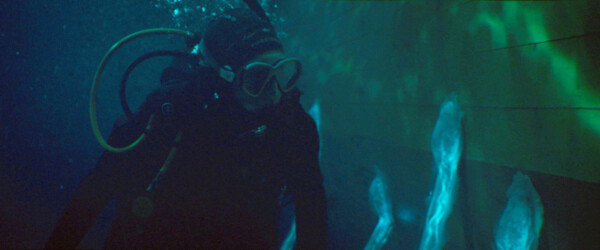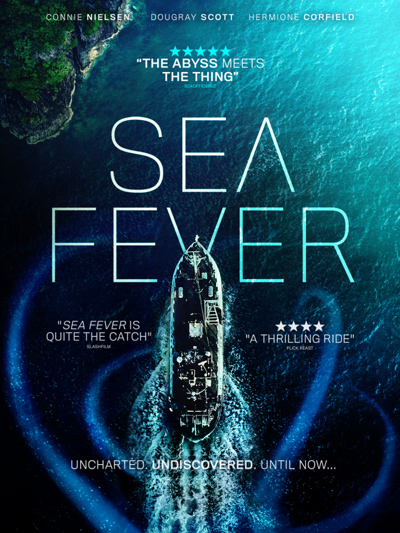Del and Mladen review ‘Sea Fever’

Image courtesy of Signature Entertainment.
“Sea Fever” Starring Hermoine Corfield, Dag Malmberg, Jack Hickey, Dougray Scott and others. Directed by Neasa Hardiman. 95 minutes. Unrated. Hulu, Vudu, Google Play, Amazon Prime, Apple TV+, YouTube.
Del’s take
Oh goodie. Let’s distract ourselves from the pandemic by watching a movie about a pandemic.
Not a pandemic per se but a parasitic infection that threatens to wipe out the crew of an Irish fishing trawler plying the chilly waters of the North Atlantic. That’s the gist of “Sea Fever,” a pretty good little monster movie from director Neasa Hardiman. If films speak to the times, “Sea Fever” is the voice of our COVID-19 consciousness, transposing our empty streets and restaurants with the vacant horizon of the open ocean.
The plot is familiar to fans of “Alien,” “The Thing” and even “The Shining.” Lonely, friendless PhD student Siobhán (Hermoine Corfield) has booked passage on the Niamh Cinn Óir, a rust bucket Irish fishing trawler, to study the behavior patterns of aquatic fauna. The Niamh Cinn Óir is owned and operated by the husband-and-wife team of Gerard (Dougray Scott) and Freya (Connie Nielson); and a crew of four others. Life has not been grand for Gerard and Freya, and they need a good haul this trip or they’ll lose the trawler.
On the trip out they detect a large mass of fish which unfortunately lies within a government-declared exclusion zone. It would be a terrible thing if they accidentally drifted into that exclusion zone and caught a hold full of mackerel, thus saving the Niamh Cinn Óir from receivership and preserving the crew’s livelihoods. Well gosh darn it, guess what happens.
Sometimes exclusion zones exist for more reasons than bureaucratic capriciousness, especially in movies that isolate a small group of people and pits them against a seemingly unbeatable antagonist. It is at this point “Sea Fever” becomes a metaphor for the COVID-19 pandemic as the fishing trawler crew battles a weird aquatic parasite that threatens to kill them all.
But “Sea Fever” operates on a second level, one that addresses the pandemic of loneliness that has infected the world since the invention of digital technology. On her first field study, Siobhán is forced to step out of her reclusive shell and interact, if not befriend, the crew, especially after they discover she’s a redhead (apparently redheads are considered bad luck among Irish fishermen). As the movie progresses along its somewhat predictable trajectory, Siobhán becomes more and more human as her environment descends into science fiction nightmare.
Somehow indie directors always manage to find strong actors to fill their roles and “Sea Fever” is no exception. All the performances are very good but my favorite was Olwen Fouéré as Ciara, the boat’s cook, who carried herself with a chafing blue collar dignity that seemed to perfectly capture the soul of the part. Another strong performance was delivered by Ardalan Esmaili as the boat’s principled and skillful engineer. Weakest was Dougray Scott, whose character hovered somewhere between effective leader and simpering cad. He seemed incapable of communicating the moral ambivalence of a man caught between financial necessity and obeyance of the law.
My gripes with “Sea Fever” are that it wraps up with an anticlimax that feels rushed and out of character for protagonist Siobhán, and the crew’s attempts to resolve their problem seem truncated and drama-less. What would Ellen Ripley have done had she been aboard the Niamh Cinn Óir? That might have elevated the tension considerably.
Still, “Sea Fever” is, as I said, a pretty good little monster movie and your time will not have been wasted, if monster movies are your bag. As American movies become more and more templated by the MBAs working in Hollywood these days, it’s nice to see a movie that still has character and a beating heart.
I grade “Sea Fever” a B or maybe even a B+.

Mladen’s take
Desperation. Superstition. Science. And, a cnidarian. Say it with me, “cnidarian.” I adore that word. It wasn’t in my plain old lexicon of the English language. I had to look it up in my Oxford Dictionary of Science. Cnidarian. Cnidaria is a phylum of aquatic invertebrates that includes hydra, jellyfish, sea anemones, and coral, by the way.
In “Sea Fever,” the crew of the fishing vessel Niamh Cinn Óir become the victims of a cnidarian unknown to humanity. First, the oversized spineless predator whose centrally placed orifice is both mouth and anus, attacks their boat and then it attacks them with its eye-eating larvae.
Where Del sees a SARS-COV-2 angle to “Sea Fever,” I see a straight-up Nature will always kick Man’s ass statement in the film. Humanity believes it controls the planet. The planet disagrees. That disagreement takes many shapes. Climate change. Water shortages. Invasive species. A snowstorm in Texas that has Tumbleweed Cruz abandoning the state he represents in the U.S. Senate to flee to warm and socialist Mexico.
Though the encounter with the cnidarian drives the plot of “Sea Fever,” the story is also about society-induced desperation. The boat owner, who’s married to the captain, has to land a good catch to earn euros to keep the vessel. With that thought plaguing the couple, the captain takes a risk and then the boat owner takes a risk. Both prove fateful.
There is superstition aboard Niamh Cinn Óir. Marine biologist Siobhán, on the boat to conduct field research that her PhD advisor ordered her to do, has red hair, which, as Del points out, the crew consider bad luck. But, there’s also the superstition of religion. There is prayer for a safe journey. There is prayer for a good haul of fish. There are prayers for the dearly departed. And there’s the belief that God will yet protect the crew.
There is science aboard the boat. Siobhán, applying her knowledge, figures out enough about the big cnidarian to give the crew somewhat of a fighting chance to live.
But, in the end, neither God nor science are much help. What mattered was one person sacrificing for another.
“Sea Fever,” as Del claims, is a pretty good little monster movie. I would amend that observation with, “pretty good little sci-fi monster movie.” Though not laden with science, the movie has moments of science-y jargon – “cnidarian” for example – and “bioluminescence” and “holopalegic” and a portable, computer-powered microscope, and talk of water filtration system design. There was the hypothesis that the cnidarian normally parasitizes whales (the fishing boat was in an exclusion zone that existed to protect cetaceans and their calves) and might have mistook the passing shadow of the vessel as a sign of its normal prey.
Between trying to stay alive while a gelatinous, tentacled predator treats them as a larder for its babies and keeping themselves from going berserk under the pressure of looming infection, the crew has to struggle with a bigger question. Is it ethical to return to port when some, if not all, of the crew are nurseries for a novel parasite that could, or is it would, infect landlubbers? Poof, see you later, humanity.
The problem with “Sea Fever” is that it added baggage that didn’t need to be in the film. Too much time was used to set up Siobhán as a loner and it was unconvincing. Del mentioned that the cook carried herself “with a chafing blue collar dignity.” Chafing she was, but it was me who got chafed. The cook went from a semi-pleasant grandmotherly type to an old crone who wanted to kill my beloved Siobhán. What would be the point of killing the one person who had the technical know-how to help people stay alive?
Regrettably, I find myself in the unforgivable situation of agreeing with Del. “Sea Fever” is a B. But for a couple of tweaks, including more encounters with momma cnidarian, this movie would have easily catapulted to an A.
Mladen Rudman is a former journalist and technical writer. Del Stone Jr. is a former journalist and author.
![]()
Leave a Reply